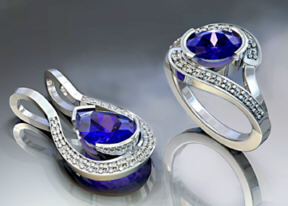950 Palladium: Laser Welding Techniques
According to Frank McAllister, the quantity of individual pieces of jewelry made from 950 palladium has surpassed the same for platinum products in the recent months. McAllister, CEO of the Stillwater Mining Co. calculated this based upon the number of ounces used globally for each alloy. It wont be long before light, bright and white 950 palladium products find their way into your store, either as merchandise from your customers jewelry taken in for service or alteration or work required to customize 950 palladium jewelry from your own inventory.
5 Minute Read
According to Frank McAllister, the quantity of individual pieces of jewelry made from 950 palladium has surpassed the same for platinum products in the recent months. McAllister, CEO of the Stillwater Mining Co. calculated this based upon the number of ounces used globally for each alloy.
It won't be long before light, bright and white 950 palladium products find their way into your store, either as merchandise from your customers' jewelry taken in for service or alteration or work required to customize 950 palladium jewelry from your own inventory.
The equipment settings and technical procedures for laser welding 950 palladium products differ from those specified for products made from platinum. This installment features research results and techniques used for successful laser welding of 950 palladium products in the following three most requested bench tasks:
- Filling voids and pits
- Minor assembly
- Ring sizing
Laser Welding 950 Palladium
Brenda Warburton, Austin & Warburton in Ann Arbor, MI conducted the research and Hoover & Strong provided the examples for this overview. Related details for the research were provided by Tyler Teague of Jett Research, and Stewart Grice of Hoover & Strong. For this research, Warburton used a Rofin StarWeld Laser machine with pulse forming capabilities. It is important to remember that laser welding equipment varies by manufacturer, so the settings listed in this reference are specific to the equipment being used. Overall maintenance of equipment can also have an affect on the settings and final outcome.
Filling Voids and Pits
Minor Assembly
For assembly of palladium pieces, the most efficient manner was to tack the parts using a laser. This procedure was then followed by torch soldering to complete the process. In the example, the top portion of the earrings consists of 3 partial bezels and a jump ring. These pieces are tacked for temporary joining. The pieces are then checked for proper alignment and adjustments are made before the final arrangement is torch soldered. The following procedures were used to obtain the best results for laser tacking prior to torch soldering and final assembly.
The equipment settings were 250 Volts, 5 to 10 ms, 1.3HZ with a beam or focus of 5 to 15. (The variables depend upon the size of the components being joined.)
99% pure argon was used. When tacking only, it is not necessary to use weld-filling wire. This procedure included pulse shaping.
Tip: According to resources at the Rofin website, laser welding success with any alloy depends both on material properties like temperature dependent reflectivity, heat conductivity or viscosity as well as specific laser parameters like pulse energy, spot diameter or temporal pulse intensity. Pulse shaping calls for a series of settings used in progressive pulses. Each setting factors both the duration of the pulse of energy and the total amount of energy used, for optimal control.
The pulse shaping technique can be used to avoid over-heating of the material, because the series begins with high laser intensity, and then incrementally reduces laser power, once the melting point has been reached. Pulse shaping can also reduce cracking in the metal which can occur during quick cooling of a weld, important for 950 palladium alloys.
Pulse shaping for 950 palladium alloys used for this research included 6 incremental steps.
| Reference | X (Pulse Duration) | Y (Total Energy) |
| 1 | 0 | 90% |
| 2 | 20% | 100% |
| 3 | 40% | 100% |
| 4 | 50% | 70% |
| 5 | 80% | 30% |
| 6 | 100% | 20% |
Warburton prefers the binocular optics with her laser welder. At a glance, she can look up at the blue panel to determine the settings and review the related detail. For non-magnified viewing of the actual piece, she can look down and see it though the amber colored work window.
Ring Sizing
Research is continuing regarding the best options for using the laser with 950 Pd products. Watch this article series for continued information.
You assume all responsibility and risk for the use of the safety resources available on or through this web page. The International Gem Society LLC does not assume any liability for the materials, information and opinions provided on, or available through, this web page. No advice or information provided by this website shall create any warranty. Reliance on such advice, information or the content of this web page is solely at your own risk, including without limitation any safety guidelines, resources or precautions, or any other information related to safety that may be available on or through this web page. The International Gem Society LLC disclaims any liability for injury, death or damages resulting from the use thereof.
The All-In-One Jewelry Making Solution At Your Fingertips
When you join the Ganoksin community, you get the tools you need to take your work to the next level.
Trusted Jewelry Making Information & Techniques
Sign up to receive the latest articles, techniques, and inspirations with our free newsletter.
